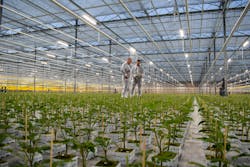Proving that it is possible to have too much of a good thing, a Dutch tomato propagator had to dial down the hybrid LED/HPS (high-pressure sodium) lighting in a new greenhouse because growth was outpacing the tomatoes in an existing greenhouse and thus upsetting the overall crop cycle.
The good news is that the illumination that Westlandse Plantenkwekerij (WPK) installed in the new greenhouse at its s-Gravenzande facility resulted in what WPK has described as a higher-quality tomato than those grown exclusively under HPS lights in the existing greenhouse at the site, yielding an advantageously compact morphology and darker and richer colors.
The problem was that the quality plants were coming on too fast.
So WPK “(reduced) the lighting hours to keep the propagation period equal and limit the differences between plants grown in the old and new facilities,” a spokesperson for LED luminaire provider Fluence told LEDs Magazine.
The combination LED/HPS installation covers 3 hectares and took about 2 weeks to complete in August 2021. Austin, TX–based Fluence provided its VYPER series LED luminaires, and The Hague-based Industria provided the HPS fittings. The parties declined to reveal how many fixtures they installed, but the LEDs accounted for about two thirds and the HPS about a third, the Fluence spokesperson said.
WPK originally chose to mix HPS with LED because it wanted the extra heat that the less energy-efficient HPS would provide, according to Fluence. (A number of growers have made similar decisions, as the added ambient heat can be beneficial in the winter). Also, energy prices had not yet spiked up in the spring of 2021, when WPK made its investment decision, the spokesperson said. A relative unfamiliarity with LED might have also encouraged WPK to include HPS in the mix.
After discovering that tomato growth was racing ahead in the new facility, WPK decided to turn down the illumination. With energy prices on the rise, the grower chose to pare back on the more energy-hungry HPS lights.
“During winter, the hours of HPS lighting were reduced to a minimum in favor of LED,” Fluence said. WPK actually ran the LEDs longer than it ran the HPS lights in the adjoining, existing HPS-only greenhouse, since the LEDs “have an intensity of 60 μmol/m2/s and HPS fixtures have an intensity of 72 μmol/m2/s,” the spokesperson noted.
WPK also propagates cucumbers, peppers, eggplants, flowers, and other plants, although most of the action in the hybrid lighting greenhouse involved tomatoes.
The Made, Netherlands–based company runs the s-Gravenzande facility in partnership with another Dutch horticultural outfit, Plantenkwekerij P. van Geest, based in Naaldwijk. It set out on the new lighting mission to save energy and improve quality as well as to facilitate a consistent quality.
"After installing Fluence’s LED lighting solutions, we learned that young plants thrive in LED-lit environments," said WPK managing director Erik van der Arend. "This has allowed us the flexibility to grow a wide range of crops in the same environment and under the same lighting conditions, decreasing hassle and improving our energy costs. The transition to Fluence has helped improve plant quality and speed of development, ensuring our customers get a uniform product that is consistently excellent."
The Fluence spokesperson said that the energy reduction at the new facility was around 40% to 50% (presumably compared to the existing HPS-only greenhouse).
WPK operates about 19 hectares in total across four different locations. It sells its propagated plants to growers and greenhouses that take them to the harvest stage.
Hungry for more horticultural/agricultural lighting?
First look at California Energy Code requirements for horticultural lighting
The other side of UV: It grows things, too
For strawberries only: Signify tailors a lighting system for just one fruit
MARK HALPER is a contributing editor for LEDs Magazine, and an energy, technology, and business journalist ([email protected]).
For up-to-the-minute LED and SSL updates, follow us on Twitter. You’ll find curated content and commentary, as well as information on industry events, webcasts, and surveys on our LinkedIn page and our Facebook page.






